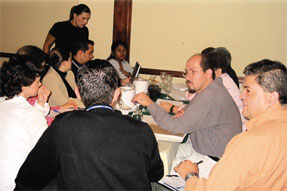|
Creation of an integrated model for disaster information management
By
Ileana Sánchez / CRID

CRID
will soon begin preparations for the creation of an integrated model
for disaster information management. With the purpose of holding
a consultation process for this initiative and, from the beginning,
foster the participation required to develop it, a first Regional
Meeting was held in San José, on September 21-22, 2004, gathering
36 professionals from different countries who represented 20 national
institutions and regional organizations.
Contents
This
model will analyze and interconnect all urrent relevant aspects
for the establishment, development and management of disaster information
centers. Along these lines, it is expected that the following topics
be included in this model:
•
Theoretical and conceptual foundations: the meaning of information
as a means for
knowledge communication, and its pivotal role in those activities
included in risk management (research, planning, education, etc.)
• An optimal and functional profile of information centers
that specialize in disaster and related issues.
• Actions involved in the creation of information centers,
based upon an approach to strategic planning.
• Information center management.
• Information management.
• Working methodologies and technological options: technological
infrastructure, designand implementation.
• Knowledge transfer for staff development (training), educational
aspects, and appro- priate methodologies for outreach activities.
Taking
into consideration the thematic structure and educational features
of this model, it may be defined as a handbook. However, since it
does not represent a closed operational guide but an educational
and reference tool applicable to multiple particular situations,
it was decided to use the concept of working model to classify this
product.
Basically,
this model will include the systematization of all experiences gained
by CRID while working on and supporting the creation and management
of information centers, such as the Central American Network for
Disaster and Health Information (CANDHI). It is worth mentioning
that the US National Library of Medicine (NLM) will offer technical
assistance, and that both the Pan-American Health Organization (PAHO/WHO)
and the UN International Strategy for Disaster Reduction (UN ISDR)
have provided the financial resources required to develop this project.
In addition, the aforementioned Regional Meeting helped develop
links with other regional institutions in order to establish collaboration.
Finally, various consultants will be hired to work towards this
goal.
Expected
outcome
It
is expected that this reference model will serve as an effective
tool that supports the planning, evaluation, implementation and
training actions included in this process for designing, establishing
and developing information centers.
In
this context, results will be primarily reflected on the creation
and strengthening of these information centers and, indirectly,
on the progress made in risk management by organizations, projects
and communities that benefit from this model.
Beneficiaries
In
line with this plan, the project is intended for two types of beneficiaries:
a)
Direct beneficiaries: institutions, groups and individuals interested
in implementing or improving organized initiatives related to disaster
and risk information services.
b)
Indirect beneficiaries: current and future users of these services.
As
stated before, a number of organizations are interacting while preparing
this educational material. In addition, the model will be designed
in such a way that it will be used in an interactive manner. In
other words, the cooperating organizations involved and CRID itself
will have the valuable opportunity to receive feedback when designing
and using the model.
Finally,
since both the interest and applicability of its contents may be
extended to other knowledge areas, as well as to a number sectoral
and institutional actions, the model will have a multipurpose feature:
its theoretical, methodological and technical aspects will be of
interest to different fields of social development, such as public
health and education.
Duration
It
is anticipated that the creation and validation of this new model
will require 12 months.
We
encourage you to keep informed about this project, and we welcome
your comments and suggestions.
|




